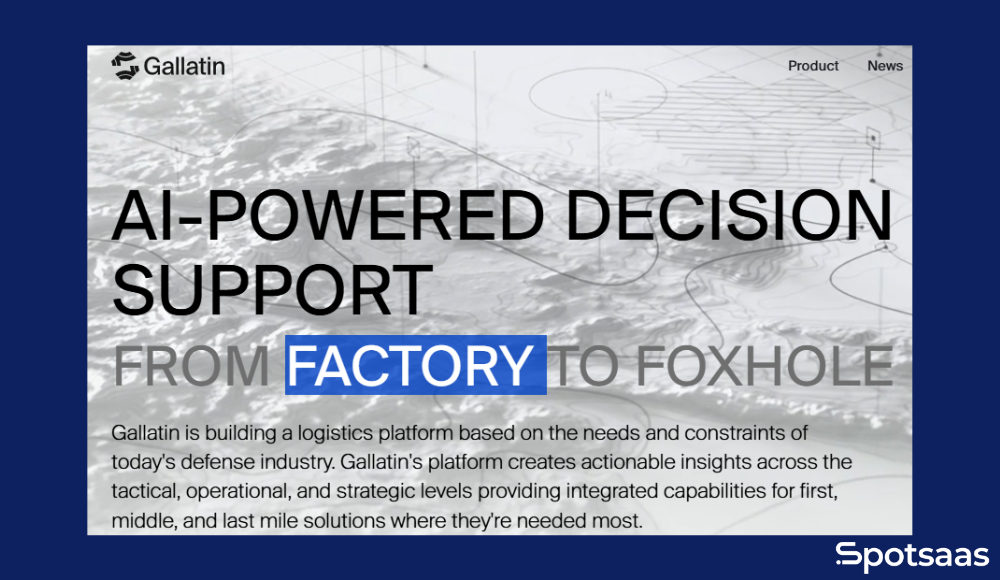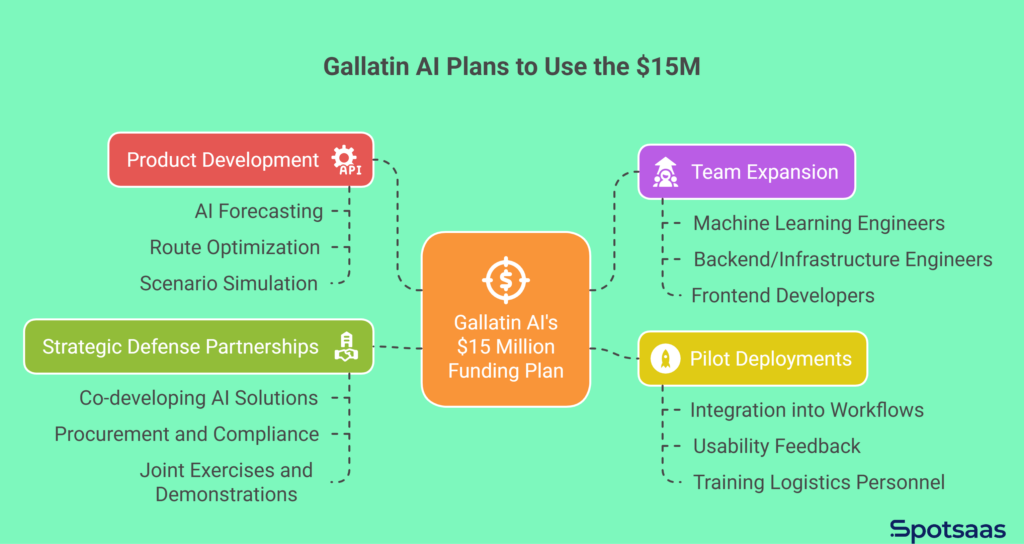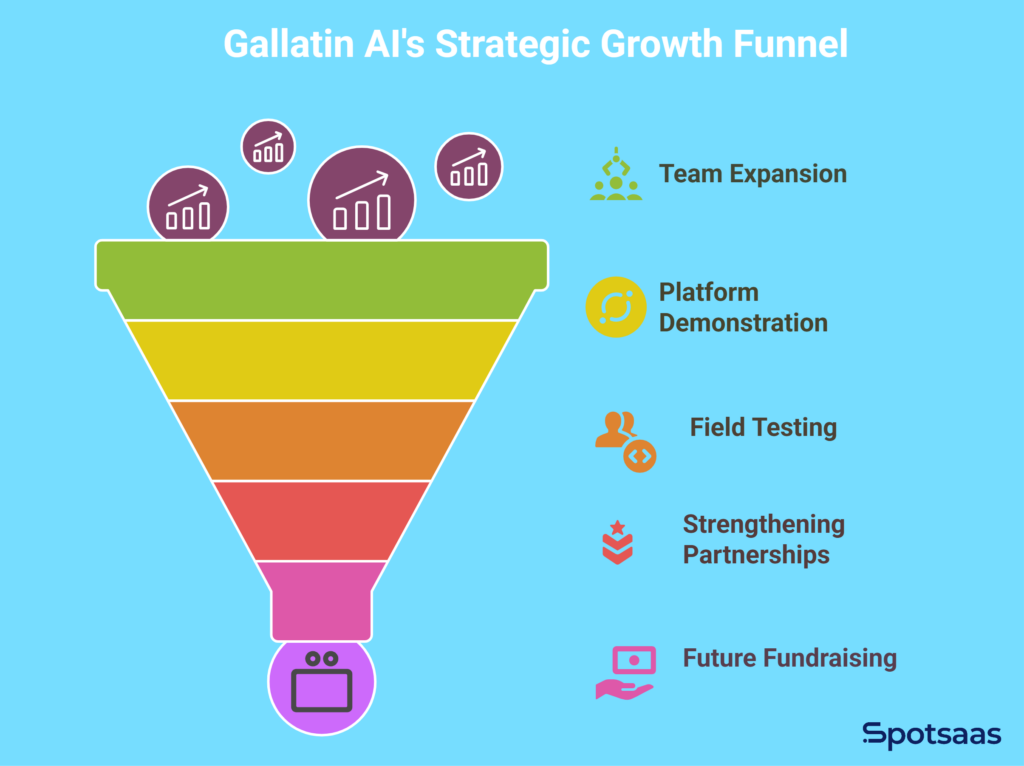Gallatin AI has raised $15 million in seed funding to develop AI-powered infrastructure for military logistics. Based in Washington, D.C., the startup is building technology to help defense forces deliver critical supplies faster and more efficiently, even in complex or contested environments.
With support from leading investors and growing interest across the defense sector, this funding marks a key step in Gallatin AI’s mission to modernize logistics at scale.
In this blog, we’ll break down what the funding means, how Gallatin plans to use it, what their platform does, and why it matters for the future of military operations.
What Is Gallatin AI?
Founded in 2024, Gallatin AI was built to rethink how the military approaches logistics. In traditional systems, logistics planning is heavily manual, siloed, and prone to error. This becomes a huge risk when forces are deployed in fast-moving or hostile environments.

Gallatin’s founding team is uniquely suited to tackle this problem:
- Woody Glier, CEO, formerly at Palantir Technologies, brings experience in building secure data systems for government and defense.
- Daniel Buchmueller, CTO, previously an executive at Amazon, understands how to build high-scale, distributed infrastructure.
- Brian Ballard, CPO, has led teams at Scale AI and other machine learning-driven platforms.
Together, they’re building a platform that uses AI not just to track supplies, but to make intelligent, forward-looking decisions that support troops on the ground.
Seed Funding Details
In April 2025, Gallatin AI raised $15 million in seed funding to scale its AI-driven logistics platform for the defense sector.
The round was led by 8VC, a venture capital firm with a strong track record of backing transformative companies in defense, biotech, and infrastructure. Known for its focus on “American dynamism,” 8VC supports startups building foundational technology for national resilience.
Joining 8VC in the round were:
- Banter Capital – a newer entrant with interest in dual-use and AI-first infrastructure playste product development, and grow a technical team capable of supporting sensitive, complex systems in the field.
- Silent Ventures – a firm that often backs companies in AI, defense, and frontier tech.
- Moonshots Capital – a veteran-led fund that supports mission-driven startups, particularly in national security.
- Timeless Partners – known for investing in next-generation enterprise and government technology.
This investor group brings not just capital, but deep strategic value ranging from national security expertise to experience scaling dual-use technologies that serve both government and commercial markets.
How Gallatin AI Plans to Use the $15 Million
Gallatin AI has laid out a clear, strategic roadmap for how it will use its $15 million seed funding. Unlike many early-stage tech startups focused solely on product-market fit, Gallatin is building foundational, field-ready infrastructure designed for national defense use.
Every dollar is being directed toward accelerating product capabilities, growing a mission-focused team, proving the platform in real-world military environments, and securing strategic footholds inside the defense ecosystem.

Product Development
A significant portion of the funding is dedicated to strengthening Navigator, Gallatin’s AI-native decision support system for military logistics.
This platform aims to serve as the digital backbone for supply coordination, resupply planning, and real-time logistics decision-making.
Key improvements and investments include
- Advanced AI forecasting to predict future supply needs based on historical usage, mission data, and real-time field reports
- Dynamic route optimization that factors in threats, terrain, weather, and availability of transport assets
- What-if scenario simulation tools to help commanders prepare for supply chain disruptions or last-minute changes in mission scope
- Cross-supply class integration, covering everything from ammunition and rations to fuel, water, and medical supplies
- Cloud-to-edge capability so the system works even in disconnected or degraded communication environments
These upgrades are all aimed at one goal: enabling faster, smarter resupply decisions that reduce delays, avoid shortages, and keep missions on track.
Team Expansion
Building a defense-grade platform requires a team that understands both software engineering and the operational realities of the military.
Gallatin AI plans to significantly grow its workforce across its two core hubs—Washington, D.C., for proximity to decision-makers and federal partners, and El Segundo, CA, to tap into top-tier technical and aerospace talent.
Planned hiring areas include
- Machine Learning Engineers to refine prediction models and increase automation accuracy
- Backend/Infrastructure Engineers to ensure scalability, security, and performance
- Frontend Developers to create clean, intuitive interfaces that work in the field
- Deployment Ops Specialists to manage field testing, user onboarding, and customer support
- Defense Strategy Liaisons to align platform development with real-world military logistics
This hiring push ensures Gallatin can not only build the tech—but also deploy, maintain, and evolve it in real-world military operations.
Pilot Deployments and Real-World Testing
Funding will also support expanded pilot deployments with U.S. military partners. These pilots are vital for validating the platform in live, operational contexts—where timing, scale, and risk are far different from lab environments.
Key goals of the pilot programs include
- Integrating Navigator into current military workflows
- Collecting real-time feedback to improve usability and operational accuracy
- Stress-testing in mission environments such as joint training exercises or emergency simulations
- Training logistics personnel to use the system effectively in active duty scenarios
These programs are essential to proving real-world value and operational readiness before scaling to multi-branch deployment or broader adoption across the defense sector.
Strategic Defense Partnerships
Gallatin is investing in collaboration with major defense contractors and government integrators to accelerate adoption. A key relationship is with Booz Allen Hamilton, a veteran defense consulting firm deeply involved in logistics modernization efforts.
Together, they’re tackling the challenge of contested logistics—supply operations disrupted by cyber threats, hostile terrain, or direct enemy interference.
This part of the funding will go toward
- Co-developing AI solutions that integrate with existing defense systems
- Navigating procurement and compliance to ease the pathway to government contracts
- Building operational credibility through joint exercises and demonstrations
- Positioning Gallatin as a reliable provider of national defense logistics infrastructure
This partnership-focused approach ensures Gallatin’s platform isn’t just innovative it’s viable, trusted, and ready for scale inside complex defense environments.
The Navigator Platform: AI for Mission-Critical Decisions
Navigator is the backbone of Gallatin’s offering. It’s not just software—it’s a command-and-control tool that transforms how resupply decisions are made.
Here’s what sets it apart:
- AI-Driven Recommendations: Rather than presenting raw data, Navigator offers actionable courses of action.
- Simulation Engine: Users can test different logistics plans before committing to one.
- Cross-Supply Class Support: Navigator manages multiple categories at once from food and water to fuel, ammunition, and spare parts.
- Visibility Across the Chain: Every unit in the supply chain sees the same up-to-date picture.
This is about more than efficiency. In military operations, a delay or error in logistics can cost lives. Navigator helps reduce that risk.
Why This Funding Round Matters
$15 million in seed funding might not sound like a lot in Silicon Valley terms—but in the world of defense AI, it’s a strong signal.
It shows that investors believe:
- AI will play a foundational role in future military operations
- Startups can successfully sell into government and defense markets
- Gallatin’s team and product are strong enough to compete with legacy players
It also reflects a growing shift toward dual-use technology—tools that serve both military and commercial markets. Gallatin’s focus on infrastructure (not just niche tools) positions it well for future expansion.
What’s Next for Gallatin AI
With $15 million in seed funding secured, Gallatin AI is entering a pivotal phase focused on execution.
Over the next 12 to 18 months, the company aims to move from early-stage product validation into real-world deployment and measurable impact. This period will be crucial for proving the platform’s reliability, value, and scalability within defense logistics environments.

Team Expansion and Hiring Push
Gallatin is scaling its team to support this next phase. The company plans to hire across engineering, operations, and strategy, with an emphasis on candidates who bring experience in AI, defense systems, and enterprise-grade infrastructure.
Key hiring priorities include:
- AI/ML engineers to advance forecasting and decision models
- Backend developers for system scalability and security
- Field deployment specialists with defense or logistics experience
- Product managers focused on user workflows and military integration
This talent expansion will allow Gallatin to accelerate feature development, handle new deployments, and support customers in both testing and live environments.
Demonstrations and Field Deployments
Gallatin AI is preparing to run live demonstrations of its Navigator platform, showing how the system performs in logistics scenarios modeled after real-world defense operations.
These demos will be used to build trust with potential partners and agencies while highlighting Navigator’s ability to support rapid, informed decisions in complex environments.
The company will also deepen its field testing efforts, expanding pilot programs to gather operational feedback and stress-test the platform in joint exercises and live logistics chains.
Expected outcomes include:
- Real-time feedback on Navigator’s performance
- Usability insights from military logistics teams
- Data on supply accuracy, planning efficiency, and mission readiness
Strengthening Defense Partnerships
Gallatin’s collaboration with key players like Booz Allen Hamilton will continue to expand, especially around high-priority challenges such as contested logistics. These partnerships are essential for aligning Gallatin’s technology with real military needs and for navigating the procurement and integration process within defense programs.
The company is also expected to pursue additional partnerships with military branches and other defense integrators to broaden adoption and operational reach.
Preparing for Future Growth
While the current focus is on execution, Gallatin is also beginning to lay the groundwork for future fundraising. If it meets its deployment milestones and proves out the platform’s value in the field, the company is likely to pursue a Series A round to support larger-scale adoption across defense sectors.
This next phase is about traction—hiring the right people, showing results in the field, and proving that AI can materially improve how military logistics are planned and executed. If Gallatin AI succeeds in these goals, it could quickly establish itself as a foundational player in the future of defense technology.
Conclusion
Gallatin AI is tackling one of the most critical and under-innovated areas in defense: logistics. With $15 million in fresh funding, a veteran founding team, and early traction inside the U.S. defense system, they are on a clear path to becoming a major player in national security tech.
By bringing AI into logistics decision-making, Gallatin is helping ensure that military forces are better equipped, more agile, and more resilient in the face of evolving threats. And in a world where conflicts are becoming more complex, that capability isn’t just useful—it’s essential.




